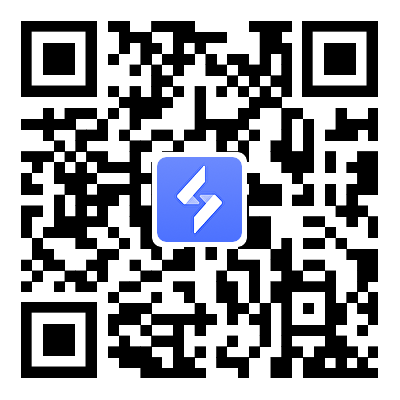Best Remote Desktop Software for Gaming (2025) – Top 7 Apps Ranked
2025-08-29
Gamers often search for remote desktop solutions to overcome all the hardware limitations. So that they can run the most demanding PC titles with a slight effort and smoothly without the need for a high-end setup, remote desktop software comes as the best option to overcome your hardware limitations, but what is the best remote desktop software or the app you can rely on? Let's find out.
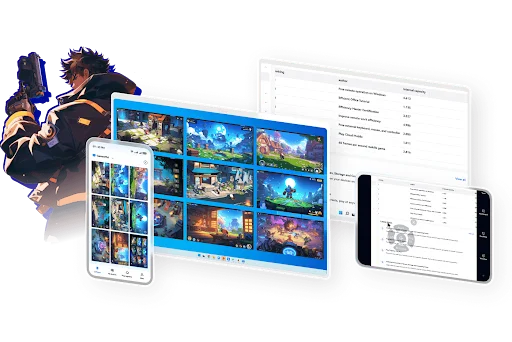
Table of Contents
OSLink
OSLink stands out as the best remote desktop software for gaming thanks to its versatile, gaming-optimized remote desktop tool and multi-instance management. With low-latency streaming and robust controller support, it provides a reliable way to play PC games on Android or iPhone. Its real strength lies in letting you run multiple mobile game instances at once, perfect for managing several accounts or playing with friends across platforms.
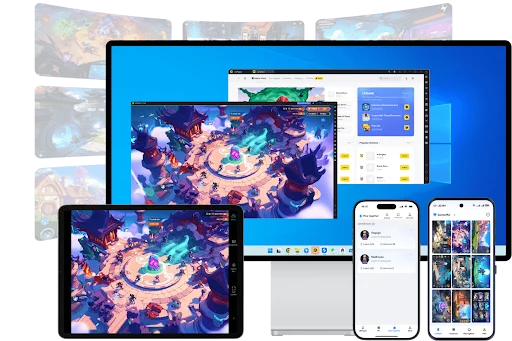
OSLink's emulator compatibility and screen-sharing features foster collaborative play, setting it apart from competitors like Parsec or Moonlight, which focus more on raw performance but lack OSLink's multi-instance versatility.
Platforms Supported: Host on Windows (7, 8, 10, 11); streams to Android and iOS devices. Supports the LDPlayer emulator for enhanced mobile gaming.
Gaming-Specific Features:
-
It streams at up to 60 FPS in HD with minimal lag and supports Bluetooth controllers, keyboards, and mice with preset key mappings.
-
Allows you to stream PC games to your mobile device and play seamlessly using touch controls.
-
Screen sharing enables collaborative play, multi-instance support allows running multiple games/apps, and real-time sync streamlines account management.
-
Secure access logs track connections, ensuring privacy.
Pricing: Free for personal use with full access to core features, including multi-instance support and controller integration. No paid tiers are mentioned for additional features, making it highly accessible.
Pros and Cons:
|
Pros |
Cons |
|
Free with robust multi-instance support for managing multiple game accounts |
Require above average network speed for remote play PC games |
|
Seamless controller integration and game-specific keymaps simplify setup |
Requires a data cable connection to enable high-response game mode. |
|
Strong security with detailed access history tracking |
Setup can be complex for Windows 7 users |
|
Ideal for mobile-to-PC gaming with emulator support |
Limited platform support compared to competitors |
Parsec
Parsec is the next best free remote desktop software for gaming that delivers peer-to-peer streaming with exceptional low-latency performance. So, this one is perfect for competitive gamers who need some precise controls and vibrant visuals. Parsec's latency and visual fidelity are good options, but its lack of multi-instance support and iOS compatibility make it less versatile for players managing multiple accounts or using Apple devices.
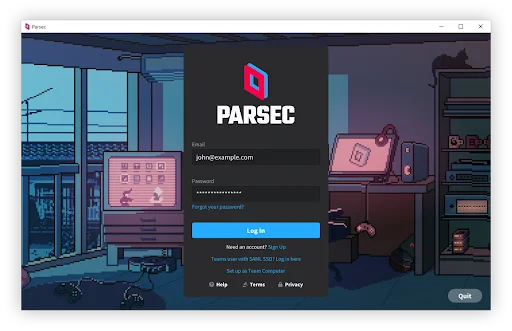
Platforms Supported: Host on Windows or macOS; streams to Windows, macOS, Linux, Android, and Raspberry Pi.
Gaming-Specific Features:
-
Streams up to 60 FPS in UHD with near-zero lag, supports multiple controllers for local co-op,
-
Enables session sharing for remote multiplayer
-
Offers keyboard mapping.
-
Paid tiers add 4:4:4 color accuracy and pressure-sensitive tablet support.
Pricing: Free for personal use with basic features. Paid plans start at $9.99/month for individuals (unlocks multi-monitor support, higher bitrates) or $30/month/user for teams.
Pros and Cons:
|
Pros |
Cons |
|
Ultra-low latency ensures responsive gameplay |
Free tier lacks advanced features like multi-monitor support |
|
Free plan supports basic gaming needs |
Requires strong internet for optimal performance |
|
Secure peer-to-peer encryption |
No iOS support, limiting mobile options |
|
Easy one-click connection setup |
Paid plans needed for premium features |
Steam Link
Steam Link offers seamless integration for Steam users. It provides a free remote desktop for gaming and a straightforward way to stream games to various devices with a multiplayer focus. Steam Link's free access and broad platform support are strong, but its restriction to Steam games and lack of multi-instance features are a bit of a challenge. So, for diverse libraries and account management, you may have to go for a better choice.
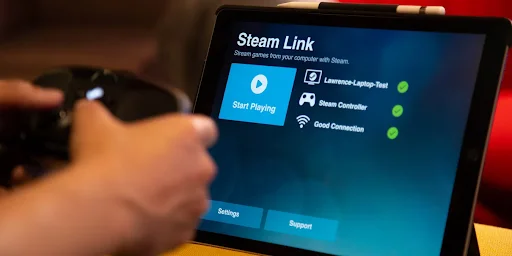
Platforms Supported: Streams from PC (Windows, macOS, Linux) to Android, iOS, Windows, macOS, Linux, smart TVs, and VR headsets.
Gaming-Specific Features:
-
Supports 4K at 60 FPS with Remote Play Together for online multiplayer
-
Pairs with Bluetooth controllers, and includes touch controls for mobile.
-
Voice chat and volume controls enhance shared sessions.
Pricing: Completely free with no paid tiers, fully integrated with Steam.
Pros and Cons:
|
Pros |
Cons |
|
Free with no hidden costs |
Limited to Steam games, reducing flexibility |
|
Easy setup within Steam ecosystem |
Can overheat mobile devices during long sessions |
|
Strong multiplayer features |
Performance varies with network stability |
|
Wide device compatibility |
No support for non-Steam titles |
Avica
Avica balances remote work and gaming, offering high-fidelity visuals and low latency for immersive play on underpowered devices. So yes, it also can be called as the best low latency remote desktop option. Avica's 4K streaming and multi-controller support are impressive, but its paid tiers for premium features and lack of multi-instance capabilities make it somewhat a low-verseatile option for gamers.
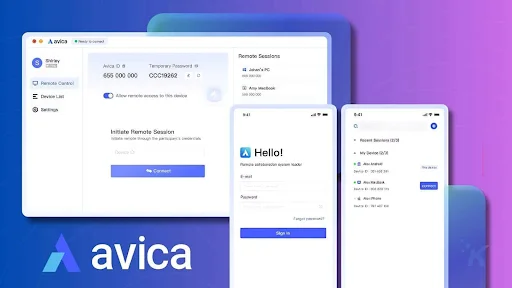
Platforms Supported: Windows, macOS, Android, iOS, and iPad.
Gaming-Specific Features:
-
Streams in 4K at 4:4:4 color depth with 10ms latency
-
Supports up to four gamepads
-
Includes 3D gaming mouse mode, and offers privacy mode.
-
File transfer and multi-monitor toggling aid game save management.
Pricing: Free plan with basic features. Paid plans start at $9.90/month for individuals (unlocks 4K streaming, multi-session support) or $19.90/month for business use (adds advanced security, team management).
Pros and Cons:
|
Pros |
Cons |
|
High visual clarity with accurate colors |
Resource-heavy on older devices |
|
AES-256 encryption for secure access |
Advanced features require paid plans |
|
Beginner-friendly interface |
Less gaming-focused than OSLink or Parsec |
|
Multi-controller support for group play |
Requires stable internet for best results |
Moonlight
Moonlight is an open-source solution for NVIDIA users. So it is the best remote desktop app for gaming, which prioritizes high performance and customization, delivering near-native gaming experiences. It's free high-FPS streaming is a strong contender among other options here, but remember, its setup complexity and lack of multi-instance are making options like OSLink much better.
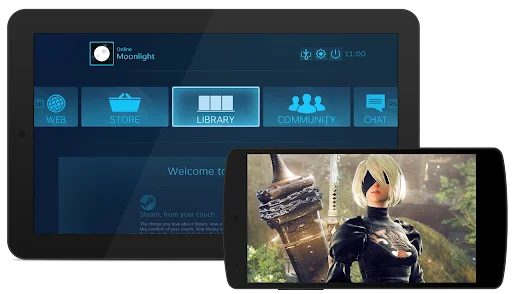
Platforms Supported: Host requires NVIDIA GPU (or Sunshine for AMD/Intel); streams to Windows, macOS, Linux, Android, iOS, Raspberry Pi, ChromeOS.
Gaming-Specific Features:
-
Streams up to 4K at 120 FPS with HDR, supports multiple controllers
-
Allows real-time encoding adjustments
-
Includes Wake-on-LAN. Ad-free with community-driven optimizations.
Pricing: Completely free and open-source with no paid tiers.
Pros and Cons:
|
Pros |
Cons |
|
Free with no subscriptions |
Complex setup, especially for non-NVIDIA users |
|
High-quality 4K/120 FPS streaming |
No built-in microphone passthrough |
|
Broad device compatibility |
Relies on community support |
|
HDR support for vibrant visuals |
NVIDIA GPU requirement limits accessibility |
AnyViewer
AnyViewer offers stable, user-friendly remote access with gaming optimizations, which is ideal for players blending work and play. This option is affordable and very easy to use. But remember, it lacks the multi-instance support as well as the 60FPS cap like OSLink has.
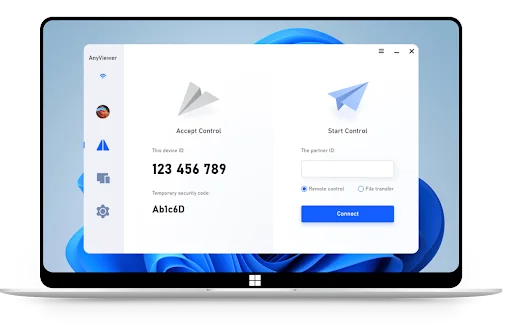
Platforms Supported: Windows, macOS, Android, iOS.
Gaming-Specific Features:
-
Streams at 60 FPS with low latency
-
Supports multi-monitor switching
-
Includes privacy mode, and enables mobile-to-PC mirroring.
-
Unattended mode ensures quick reconnections.
Pricing: Free for personal use with core features. Paid plans start at $3.58/month (unlocks multi-session support, faster speeds) or $8.33/month for enterprise (adds advanced management tools).
Pros and Cons:
|
Pros |
Cons |
|
Free plan suits casual gaming |
Limited to 60 FPS, not ideal for high-end setups |
|
Intuitive interface for easy setup |
No native Linux support |
|
Reliable on weaker networks |
Paid upgrades needed for multiple sessions |
|
Strong security features |
Less gaming-specific than OSLink |
Splashtop
Splashtop is the last option we bring you here as the best remote desktop program for gaming. It combines professional remote access with gaming capabilities, offering consistent performance for casual and developer gamers. Splashtop has a broad compatibility and audio quality that are very solid for the users, but its paid plans and lower FPS compared to OSLink's free, multi-instance-focused offering make it less ideal for dedicated gamers.
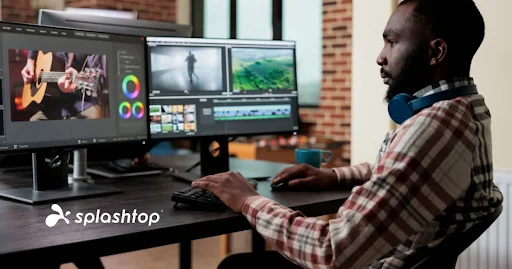
Platforms Supported: Windows, macOS, Linux, iOS, Android, Chromebook.
Gaming-Specific Features:
-
Streams in 4K at 60 FPS with high audio fidelity
-
Supports USB redirection for controllers
-
Enables multi-monitor views
-
Includes session recording for gameplay review.
Pricing: Free for local use with limited features. Paid plans start at $5/month for personal use (unlocks 4K streaming, file transfers) or $17/month for business (adds team features, enhanced security).
Pros and Cons:
|
Pros |
Cons |
|
Strong cross-platform support |
Paid plans required for full features |
|
High-quality audio enhances immersion |
Lower FPS than Moonlight or Parsec |
|
Secure for safe library access |
Resource-intensive during HD sessions |
|
Session recording for debugging |
Connectivity issues on unstable networks |
Conclusion
Remote desktop tools have become essential for gamers on the go in 2025, offering smooth performance, flexibility, and the ability to enjoy PC gaming across devices. Each of the seven apps we explored has its strengths, from accessibility to streaming quality. But for performance and gamer-focused features, OSLink stands out. With multi-instance management, emulator support, and mobile-to-PC streaming, it goes beyond remote play, helping gamers manage multiple accounts, grind smarter, and play longer. If you want a best remote desktop for gaming or a best remote desktop app built with gamers in mind, download OSLink today and see the difference for yourself.
